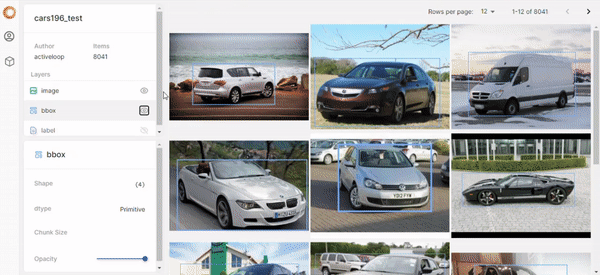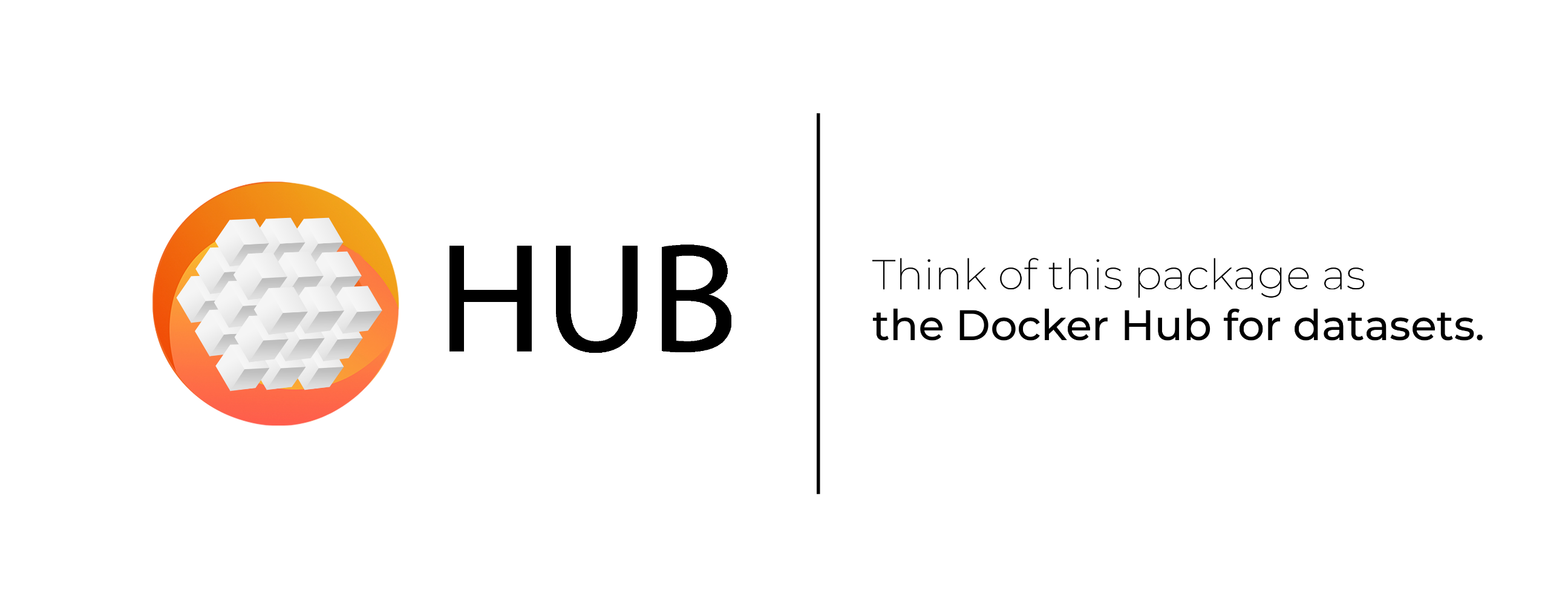Introducing Data 2.0, powered by Hub.
The fastest way to store, access & manage datasets with version-control for PyTorch/TensorFlow. Works locally or on any cloud. Scalable data pipelines.
[ English | 简体中文 | Türkçe | 한글]
Software 2.0 needs Data 2.0, and Hub delivers it. Most of the time Data Scientists/ML researchers work on data management and preprocessing instead of training models. With Hub, we are fixing this. We store your (even petabyte-scale) datasets as single numpy-like array on the cloud, so you can seamlessly access and work with it from any machine. Hub makes any data type (images, text files, audio, or video) stored in cloud usable as fast as if it were stored on premise. With same dataset view, your team can always be in sync.
Hub is being used by Waymo, Red Cross, World Resources Institute, Omdena, and others.
- Store and retrieve large datasets with version-control
- Collaborate as in Google Docs: Multiple data scientists working on the same data in sync with no interruptions
- Access from multiple machines simultaneously
- Deploy anywhere - locally, on Google Cloud, S3, Azure as well as Activeloop (by default - and for free!)
- Integrate with your ML tools like Numpy, Dask, Ray, PyTorch, or TensorFlow
- Create arrays as big as you want. You can store images as big as 100k by 100k!
- Keep shape of each sample dynamic. This way you can store small and big arrays as 1 array.
- Visualize any slice of the data in a matter of seconds without redundant manipulations

Visualization of a dataset uploaded to Hub via app.activeloop.ai (free tool).
Work with public or your own data, locally or on any cloud.
To load a public dataset, one needs to write dozens of lines of code and spend hours accessing and understanding the API as well as downloading the data. With Hub, you only need 2 lines of code, and you can get started working on your dataset in under 3 minutes.
pip3 install hubAccess public datasets in Hub by following a straight-forward convention which merely requires a few lines of simple code. Run this excerpt to get the first thousand images in the MNIST database in the numpy array format:
from hub import Dataset
mnist = Dataset("activeloop/mnist") # loading the MNIST data lazily
# saving time with *compute* to retrieve just the necessary data
mnist["image"][0:1000].compute()You can find all the other popular datasets on app.activeloop.ai.
Load the data and train your model directly. Hub is integrated with PyTorch and TensorFlow and performs conversions between formats in an understandable fashion. Take a look at the example with PyTorch below:
from hub import Dataset
import torch
mnist = Dataset("activeloop/mnist")
# converting MNIST to PyTorch format
mnist = mnist.to_pytorch(lambda x: (x["image"], x["label"]))
train_loader = torch.utils.data.DataLoader(mnist, batch_size=1, num_workers=0)
for image, label in train_loader:
# Training loop hereIf you want to work on your own data locally, you can start by creating a dataset:
from hub import Dataset, schema
import numpy as np
ds = Dataset(
"./data/dataset_name", # file path to the dataset
shape = (4,), # follows numpy shape convention
mode = "w+", # reading & writing mode
schema = { # named blobs of data that may specify types
# Tensor is a generic structure that can contain any type of data
"image": schema.Tensor((512, 512), dtype="float"),
"label": schema.Tensor((512, 512), dtype="float"),
}
)
# filling the data containers with data (here - zeroes to initialize)
ds["image"][:] = np.zeros((4, 512, 512))
ds["label"][:] = np.zeros((4, 512, 512))
ds.flush() # executing the creation of the datasetYou can also specify s3://bucket/path, gcs://bucket/path or azure path. Here you can find more information on cloud storage.
Also, if you need a publicly available dataset that you cannot find in the Hub, you may file a request. We will enable it for everyone as soon as we can!
- Register a free account at Activeloop and authenticate locally:
hub register
hub login
# alternatively, add username and password as arguments (use on platforms like Kaggle)
hub login -u username -p password- Then create a dataset, specifying its name and upload it to your account. For instance:
from hub import Dataset, schema
import numpy as np
ds = Dataset(
"username/dataset_name",
shape = (4,),
mode = "w+",
schema = {
"image": schema.Tensor((512, 512), dtype="float"),
"label": schema.Tensor((512, 512), dtype="float"),
}
)
ds["image"][:] = np.zeros((4, 512, 512))
ds["label"][:] = np.zeros((4, 512, 512))
ds.flush()- Access it from anywhere else in the world, on any device having a command line:
from hub import Dataset
ds = Dataset("username/dataset_name")For more advanced data pipelines like uploading large datasets or applying many transformations, please refer to our documentation.
The examples directory has a series of examples and the notebooks has some notebooks with use cases. Some of the notebooks are listed of below.
| Notebook | Description | |
|---|---|---|
| Uploading Images | Overview on how to upload and store images on Hub | |
| Uploading Dataframes | Overview on how to upload Dataframes on Hub | |
| Uploading Audio | Explains how to handle audio data in Hub | |
| Retrieving Remote Data | Explains how to retrieve Data | |
| Transforming Data | Briefs on how data transformation with Hub | |
| Dynamic Tensors | Handling data with variable shape and sizes | |
| NLP using Hub | Fine Tuning Bert for CoLA |
- Satellite and drone imagery: Smarter farming with scalable aerial pipelines, Mapping Economic Well-being in India, Fighting desert Locust in Kenya with Red Cross
- Medical Images: Volumetric images such as MRI or Xray
- Self-Driving Cars: Radar, 3D LIDAR, Point Cloud, Semantic Segmentation, Video Objects
- Retail: Self-checkout datasets
- Media: Images, Video, Audio storage
There are quite a few dataset management libraries which offer functionality that might seem similar to Hub. In fact, quite a few users migrate data from PyTorch or Tensorflow Datasets to Hub. Here are a few startling differences you will encounter after switching to Hub:
- the data is provided in chunks, which you may stream from a remote location, instead of downloading all of it at once
- as only the necessary portion of the dataset is evaluated, you are able to work on the data immediately
- you are able to store the data that would not fit in your memory in its entirety
- you may version control and collaborate with multiple users on your datasets across different machines
- you are equipped with tools that enhance your understanding of the data in a manner of seconds, such as our visualization tool
- you can easily prepare your data for multiple training libraries at ones (e.g. you can use the same dataset for training with PyTorch and Tensorflow)
Join our Slack community to get help from Activeloop team and other users, as well as stay up-to-date on dataset management/preprocessing best practices.
As always, thanks to our amazing contributors!
Made with contributors-img.
Please read CONTRIBUTING.md to know how to get started with making contributions to Hub.
Activeloop's Hub format lets you achieve faster inference at a lower cost. We have 30+ popular datasets already on our platform. These include:
- COCO
- CIFAR-10
- PASCAL VOC
- Cars196
- KITTI
- EuroSAT
- Caltech-UCSD Birds 200
- Food101
Check these and many more popular datasets on our visualizer web app and load them directly for model training!
Using Hub? Add a README badge to let everyone know:
[](https://github.com/activeloopai/Hub)
Similarly to other dataset management packages, Hub is a utility library that downloads and prepares public datasets. We do not host or distribute these datasets, vouch for their quality or fairness, or claim that you have license to use the dataset. It is your responsibility to determine whether you have permission to use the dataset under the dataset's license.
If you're a dataset owner and wish to update any part of it (description, citation, etc.), or do not want your dataset to be included in this library, please get in touch through a GitHub issue. Thanks for your contribution to the ML community!
This technology was inspired from our experience at Princeton University and would like to thank William Silversmith @SeungLab with his awesome cloud-volume tool. We are heavy users of Zarr and would like to thank their community for building such a great fundamental block.





